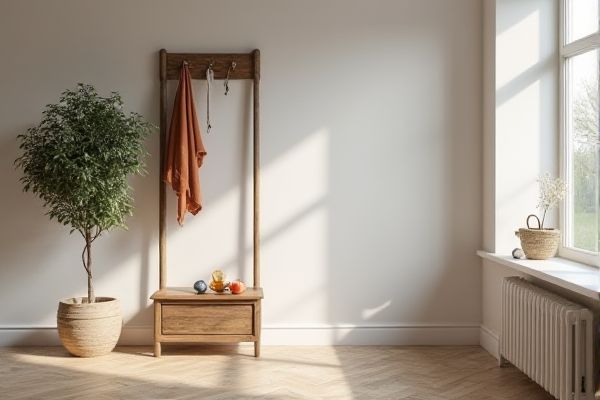
A coat stand offers a minimalist design for hanging coats and hats, while a hall tree combines functionality with seating, storage, and hooks, making it ideal for organizing entryways efficiently. Discover which option best suits Your space and organizational needs by reading the rest of this article.
Table of Comparison
| Feature | Coat Stand | Hall Tree |
|---|---|---|
| Primary Function | Hanging coats and hats | Storage and seating plus hanging coats |
| Design | Freestanding with hooks | Large, includes hooks, bench, and storage |
| Storage | Minimal, mainly hooks | Hooks, shelves, cubbies, compartments |
| Seating | None | Usually includes bench or seat |
| Size | Compact and lightweight | Larger and bulkier |
| Ideal Location | Small entryways or rooms | Spacious entry halls or foyers |
| Cost | Generally affordable | Typically more expensive |
Introduction to Coat Stands and Hall Trees
Coat stands are freestanding structures designed primarily for hanging coats, hats, and umbrellas, often featuring multiple hooks and a compact base. Hall trees combine the functions of coat stands with additional storage options such as benches, drawers, or mirrors, making them multifunctional entryway furniture. Both serve to organize outerwear efficiently, but hall trees offer enhanced space-saving solutions and aesthetic appeal for foyer areas.
Key Differences Between Coat Stands and Hall Trees
Coat stands are typically freestanding pieces designed solely for hanging coats and hats, making them lightweight and easy to move. Hall trees combine functionality with storage, often featuring integrated benches, shoe racks, and mirrors to create a versatile entryway solution. Your choice depends on whether you prioritize simple hanging space or a multi-functional furniture piece that maximizes hallway organization.
Design and Aesthetic Appeal
Coat stands typically feature a minimalist, open-frame design made from metal or wood, offering versatile placement in modern or transitional interiors. Hall trees combine functionality with style, often integrating seating, storage, mirrors, and hooks into a cohesive, statement-making piece tailored to entryways. The design of a hall tree usually emphasizes ornate craftsmanship and substantial presence, while coat stands prioritize simplicity and lightweight portability.
Space and Storage Capabilities
Coat stands offer a minimalist design ideal for small spaces, providing vertical storage primarily for hanging coats and hats without additional compartments. Hall trees combine coat hanging with built-in benches, cubbies, or drawers, maximizing storage options and organization in entryways or larger foyers. The choice between the two depends on space availability and the need for integrated storage solutions.
Material and Build Quality Comparison
Coat stands are typically constructed from lightweight materials such as metal or plastic, offering easy portability but potentially less durability compared to hall trees. Hall trees are often built from solid hardwoods like oak or walnut, providing robust structural integrity and long-lasting durability for heavy use. The high-quality craftsmanship in hall trees frequently includes integrated seating and storage, enhancing their multifunctional appeal beyond the simpler design of coat stands.
Functionality and Versatility
A hall tree combines coat storage with seating and often includes a mirror, providing multifunctional use ideal for entryways. In contrast, a coat stand primarily focuses on hanging garments without additional features, offering straightforward coat storage. The versatility of a hall tree makes it suitable for organizing umbrellas, hats, and shoes, enhancing its practicality beyond the basic function of a coat stand.
Installation and Mobility
Coat stands offer easy installation with no need for wall mounting, allowing you to move them effortlessly around your space, ideal for versatile placement. Hall trees typically require more permanent installation, often secured to the wall for stability, which can limit mobility but provides added durability for heavy coats and accessories. Your choice depends on whether you prioritize flexibility or a fixed, sturdy setup.
Ideal Uses and Placement Ideas
Coat stands offer a compact, versatile solution perfect for entryways and small spaces, providing easy access to jackets, hats, and umbrellas without overwhelming the area. Hall trees combine seating, storage, and hanging options, making them ideal for larger foyers or mudrooms where organization and multifunctionality enhance daily routines. You can place a coat stand near a front door in tight spaces, while a hall tree works well against a hallway wall to create a designated drop zone for outerwear, shoes, and accessories.
Pros and Cons of Coat Stands vs Hall Trees
Coat stands offer a lightweight, portable solution for organizing outerwear and accessories, making them ideal for small spaces but often lack additional storage features. Hall trees combine coat hooks with benches and storage compartments, providing a multifunctional entryway piece that maximizes space but typically requires more room and investment. Your choice depends on whether you prioritize mobility and simplicity or comprehensive storage and seating in your entryway.
Choosing the Right Option for Your Entryway
Coat stands offer a compact and versatile solution for entryways with limited space, providing hooks and sometimes a base tray for shoes without bulky storage. Hall trees combine seating, storage compartments, and multiple hooks, making them ideal for larger entryways that require a multifunctional piece to organize coats, hats, and shoes efficiently. Selecting between a coat stand and a hall tree depends on available space, desired storage capacity, and the functional needs of your entryway.
 homyna.com
homyna.com